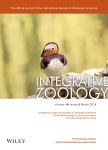Isolation of microsatellite loci and reliable genotyping using noninvasive samples of a critically endangered primate, Trachypithecus leucocephalus
作者机构:School of Life SciencesPeking UniversityBeijingChina
出 版 物:《Integrative Zoology》 (整合动物学(英文版))
年 卷 期:2016年第11卷第4期
页 面:250-262页
核心收录:
学科分类:0710[理学-生物学] 071001[理学-植物学] 07[理学]
基 金:supported by the Natural Science Foundation of China(Grant No.31272329) Project 985 Research Fund to M.Y
主 题:Asian colobine conservation genetics FIASCO hair scatology
摘 要:Genetic information can be critical in identifying conservation priorities and developing conservation *** is an urgent need for noninvasive genetic tools to study the wild populations of Asian colobine *** majority of these species are threatened with habitat destruction,population reduction and even extinction,but generally lack information on their genetic diversity and population *** sampling and tissue collection have been scarce in these species owing to strict regulations on manipulation of endangered species,and the difficulties and risks associated with capturing these arboreal and fast-moving monkeys in the challenging environments that they *** difficulties have hindered the development of molecular genetic markers,which are usually derived from tissues or *** this study,we present a method for de novo microsatellite isolation and genotyping using DNA from noninvasive origins of a critically endangered Asian colobine,the white-headed langur(Trachypithecus leucocephalus).Genomic DNA isolated from hair was shown to be sufficient for microsatellite enrichment and isolation,with similar isolation efficiencies as from tissue *** identified and characterized 20 polymorphic microsatellite loci,and evaluated their amplification success and genotyping reliability with 86 field-collected fecal *** results show that this panel of loci can produce reliable genotypes from fecal samples,and represent a useful tool for noninvasive investigation of genetic structure,individual identification and kinship assessment in this highly endangered *** approach can be applied to conservation genetic studies of other wild species that lack sequence information and tissue samples.



